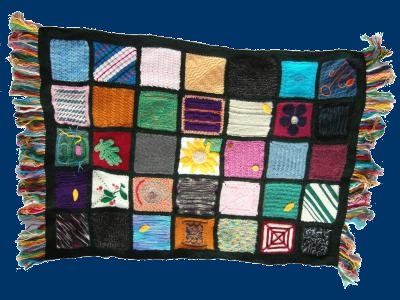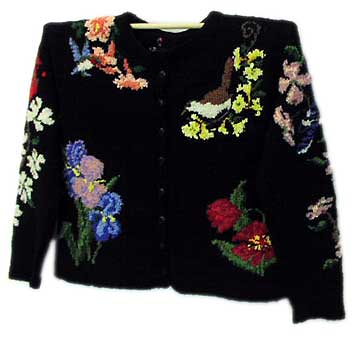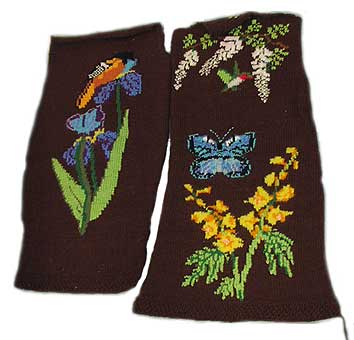Knitting Projects

I
made this vest from the first yarn I ever spun. As I learned to spin,
I started to spin ever-finer yarn, so to use the yarn in a single
project, I had to double some yarns again and again. The red yarn at
the bottom of the sweater is eight plies thick to match the other
yarns. I decided to try dyeing the yarn with Kool-Aid, because it is
safe, reasonably cheap, and it imparts a rather nice scent to the
sweater. Even now, years after I made the vest, it still smells
slightly of artificial fruit. I had to be a bit careful dyeing the
yarn, because it is 100% wool, and it could have felted, but in
general it was quite easy to dye. The colors looked like a sunset to
me, so I decided to make a blended sweater vest with a dark blue
commercial yarn to tie the disparate weights and colors of the
handspun yarns together. I chose a garter-stitch based mosaic pattern
called Odin's Eagle. This remains one of my favorite patterns. I even
made another version in sunrise colors of commercial yarn for a
friend.

I knit this headband
in two days. The pattern was created using a Cellular Automata
algorithm. The color of each stitch comes from the three stitches
below it. If the three stitches are all colored or all white, then
the stitch is colored. If not, the stitch is white. The edge of the
headband is taken to be neither colored or white, so the edge
stitches are always white.
 This
is the Wool Gathering workshop afghan. Most of the workshop
participants knit at least one square for it, even the beginners. I
adjusted the size of the squares by hemming a couple of the larger
squares and crocheting an edging around some of the smaller squares.
We tried to knit love into each square, and we gave the finished
afghan to a conference employee who was fighting spinal cancer.
This
is the Wool Gathering workshop afghan. Most of the workshop
participants knit at least one square for it, even the beginners. I
adjusted the size of the squares by hemming a couple of the larger
squares and crocheting an edging around some of the smaller squares.
We tried to knit love into each square, and we gave the finished
afghan to a conference employee who was fighting spinal cancer.
My mother made this beautiful black intarsia sweater for me from a
pattern in a magazine. She enjoyed making it, but she complained that
the person who designed it must not have been a knitter, because it
included very small areas of color that are very challenging to knit
in intarsia. I rashly told her that if she made it for me, I would
weave in all of the little ends of yarn from changing colors. I did
it, but it took me almost as long as it took her to knit the sweater!
For Christmas, I decided to design some intarsia graphics for her so
that she could make her own sweater. I chose a softer brown color for
the background. The original sweater had Southern plants and birds,
but I chose to focus on more northern flora and fauna to make my
designs special. I used irises on the sleeves, with an oriole and
blue irises on one sleeve and an indigo bunting and pink and purple
irises on the other sleeve. I also made a wisteria/hummingbird design
for the right front, with a blue morpho butterfly and yellow
snapdragons. I made my designs the old-fashioned way. Instead of
using a graph program on a computer, I freehand-sketched the pictures
onto graph paper and filled in the squares for the stitches with
colored pencils. I mentally compensated for the fact that knitted
stitches are wider than they are tall. This especially became a
factor in designing the butterfly, which I made extra-tall so that it
would not appear squat. I also used purl stitches to make the
butterfly's body more dimensional. Both the black sweater and the
pieces of the brown sweater were exhibited in the Traditional Arts in
Upstate New York exhibit “Repeat From Here: Knitting in the North
Country,” curated by Jill Breit.
 The
sweaters were featured in the section entitled “Knitting for
Creative Expression.” This is what the introduction to the section
stated: “The act of making something with one's own hands offers an
opportunity to express one's personality through choices of design
and execution. Many knitters delight in adapting published patterns
to satisfy their creative instincts; others eschew published patterns
altogether, choosing to design their pieces from the foundation up.
Individuality is revealed through preferences in color, texture, and
shaping. A willingness to experiment is essential.”
The
sweaters were featured in the section entitled “Knitting for
Creative Expression.” This is what the introduction to the section
stated: “The act of making something with one's own hands offers an
opportunity to express one's personality through choices of design
and execution. Many knitters delight in adapting published patterns
to satisfy their creative instincts; others eschew published patterns
altogether, choosing to design their pieces from the foundation up.
Individuality is revealed through preferences in color, texture, and
shaping. A willingness to experiment is essential.”
 It
occurs to me that counted-cross stitch patterns would be good for
knitting sweaters, because some similar restrictions apply in terms
of how far the thread can stretch across the back and how many
stitches minimum the knitter needs to anchor a yarn and make it worth
the two ends to weave in.
It
occurs to me that counted-cross stitch patterns would be good for
knitting sweaters, because some similar restrictions apply in terms
of how far the thread can stretch across the back and how many
stitches minimum the knitter needs to anchor a yarn and make it worth
the two ends to weave in.
HOME



 The
sweaters were featured in the section entitled “Knitting for
Creative Expression.” This is what the introduction to the section
stated: “The act of making something with one's own hands offers an
opportunity to express one's personality through choices of design
and execution. Many knitters delight in adapting published patterns
to satisfy their creative instincts; others eschew published patterns
altogether, choosing to design their pieces from the foundation up.
Individuality is revealed through preferences in color, texture, and
shaping. A willingness to experiment is essential.”
The
sweaters were featured in the section entitled “Knitting for
Creative Expression.” This is what the introduction to the section
stated: “The act of making something with one's own hands offers an
opportunity to express one's personality through choices of design
and execution. Many knitters delight in adapting published patterns
to satisfy their creative instincts; others eschew published patterns
altogether, choosing to design their pieces from the foundation up.
Individuality is revealed through preferences in color, texture, and
shaping. A willingness to experiment is essential.”
 It
occurs to me that counted-cross stitch patterns would be good for
knitting sweaters, because some similar restrictions apply in terms
of how far the thread can stretch across the back and how many
stitches minimum the knitter needs to anchor a yarn and make it worth
the two ends to weave in.
It
occurs to me that counted-cross stitch patterns would be good for
knitting sweaters, because some similar restrictions apply in terms
of how far the thread can stretch across the back and how many
stitches minimum the knitter needs to anchor a yarn and make it worth
the two ends to weave in.